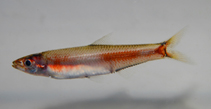| Diagnosis: |
Dorsal spines (total): 0-0; Dorsal soft rays (total): 13-17; Anal spines: 0-0; Anal soft rays: 17-19; Vertebrae: 41-43. Diagnosis: Body elongate, a little compressed; belly rounded, without pre-pelvic scutes, but a pelvic scute present with slender lateral arms; gillrakers few, 17-20 gillrakers on lower limb of first arch; pelvic fin with 1 unbranched and 7 branched finrays, a little anterior to dorsal fin origin; last two anal finrays not separate from others (Ref. 188, 33664). It is distinguished from other non-scuted clupeids of Spratelloides, Dussumieria and Etrumeus by presence of a normal pelvic scute vs. W-shaped (Ref. 188). It is distinguished from Sauvagella robusta by a higher vertebral number, 41-43 vs. 38-40; a shallower body, 15.8-21.1% of standard length vs. 20.8-27.4%; a longer snout, 26.2-33.7% of head length vs. 18.5-26.6%; and a higher anal fin ray count, 17-19 vs. 13-17 (Ref. 33664).
Description: Gracile, torpedo-shaped fishes with straight dorsal profile and little ventral curvature; snout acutely pointed and narrow, mouth slightly upturned; gape inclination approximately 30° to horizontal; upper jaw to vertical through anterior margin of orbit (Ref. 33664). Pre-maxilla with dentigerous arm extending over anterior half of maxillary shaft; pre-maxillary teeth small unicuspids, 10-12 in single row; ventral margin of maxillary flange usually serrate; single, tear-shaped posterior supra-maxilla; lower jaw teeth in single row, small unicuspids extending over anterior half of dentary (Ref. 33664). Gill rakers: 17-20 on lower limb of first arch; 8-10 elongate hypobranchial rakers, increasing in length to ceratobranchial; 11-14, narrow, elongate rakers on ceratobranchial; usually 1 raker in angle of arch; and 9-12 epibranchial rakers; row of short rakers on inner face of third epibranchial (Ref. 33664). Dorsal fin relatively long-based, usually with 3 unbranched and 10-14 branched rays; anal with 3-4 unbranched and 14-15 branched rays, origin just below or slightly anterior to end of dorsal; ventral margin of anal straight or slightly incised; pectoral fin with 11-12 rays; pelvic fin with 1 unbranched and 7 branched rays, its insertion anterior to dorsal fin origin; caudal fin emarginate with deeply forked lobes (Ref. 33664, 121271). Scales are cycloid and easily shed; 43-45 scales in longitudinal series; 8 transversal scales (Ref. 56161, 121271). Belly rounded, lacking pre-pelvic scutes and post-pelvic scutes; pelvic scute with slender lateral arms (Ref. 9391, 33664, 56161). Vertebral counts 41-43 with 22-24 precaudal and 17-19 caudal centra; first supraneural bone flat and platelike, remaining 11-12 short and tubular; hyoid arch with 5 branchiostegal rays, first narrow and filamentous, rest variously expanded, flat and broad; single row of small teeth on ectopterygoid and rodlike palatine except in smallest individuals which sometimes lack palatine dentition (Ref. 33664).
Colouration: In life, rather nondescript uniformly pale yellow with silvery iridescence on head and flanks; some larger specimens dark orange, even reddish (Ref. 33664). Preserved specimens are pale creamy yellow with varying amounts of pigment ringing dorsal scale margins, darkening the dorsum; a thin midlateral band of dark pigment is often present on flanks; dorsal, anal and caudal fins usually with a line of dark pigment along base on the body wall; silvery or black peritoneal lining of abdominal cavity often visible through body wall; pupil situated anteriorly in eye, iris silver (Ref. 33664). |

